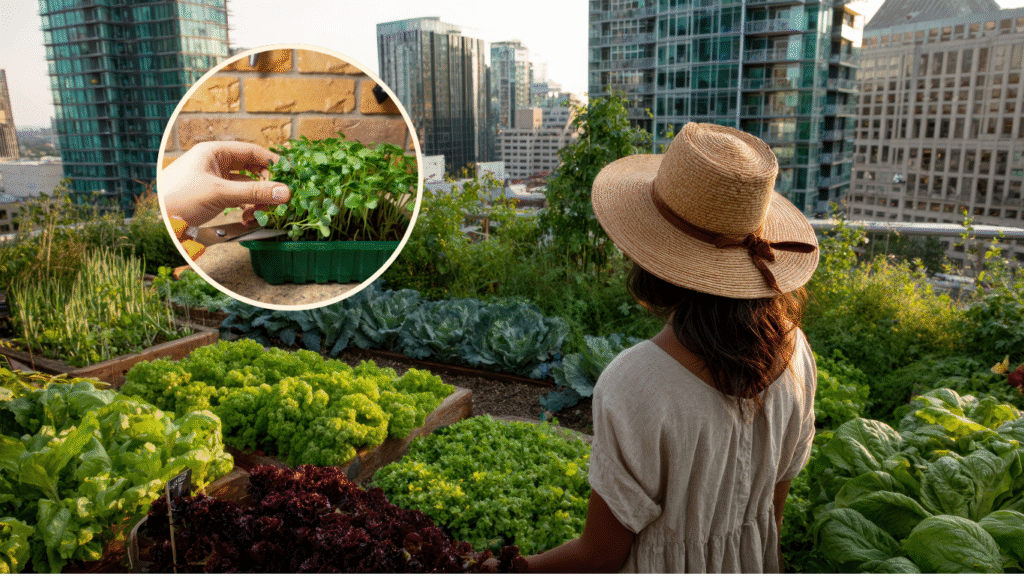Microgreens and urban agriculture I

In recent years, urban agriculture and community gardens have become an excellent alternative to the chaos and stress of big cities. Groups of neighbors from different districts have chosen to create spaces for community gardens, where people of all ages, from seniors to children, come together not only for leisure or recreation, but also to grow their own food and microgreens.
These initiatives are no longer confined to neighborhoods; many apartment buildings now use their rooftops as green spaces for planting. Likewise, individuals are transforming their balconies into small gardens and mini farms. Here in Greece, particularly in Athens, it’s common to see fruit trees, such as orange and lemon trees, growing on most balconies.
Urban gardens are not only community, educational, and recreational spaces, they also provide food, promote self sufficiency, and contribute to environmental care. This movement is very visible in major cities such as Barcelona, Amsterdam, and Mexico City.
And surely you’re all thinking the same thing: what better example than microgreens for starting your own urban garden? Indeed, microgreens represent the most accessible way to do it, since these tiny plants require very few resources and very little space to grow.
Microgreens in the city
As we’ve highlighted in many articles, we all know the incredible nutritional benefits that microgreens offer. But their importance in cities goes far beyond nutrition, their ease of cultivation and low cost make them especially valuable.
With just a handful of seeds, a tray, water, and some natural light, anyone can have a mini garden at home. There’s no need for hectares of land or machinery. For that reason, many consider them a first step toward a diet based on urban agriculture.
In densely populated neighborhoods, microgreens have enabled families with little space to produce part of their own fresh and healthy food. In schools and community centers, they have become educational tools for teaching biology, nutrition, and sustainability.1
Projects such as Huerto Urbano de Adelfas in Madrid or Proyecto Cultivarte in Buenos Aires have used these crops to connect children and young people with nature through the daily observation of plant growth. Thus, microgreens have become educational tools within the urban landscape.
In many retirement homes, spaces for gardening are also being created. Older adults take care of them, and microgreens are an excellent option because they require minimal effort, allowing participation from people with limited mobility.2
The social impact: microgreen communities
Microgreens can also bring people together and help form communities around agriculture. In many neighborhoods, urban gardens have evolved from experimental projects into centers of cohesion and community life.
In the district of Vallecas in Madrid, for example, a group of neighb ors decided to create a micro garden on the roof of a cultural center. What began as a small initiative to make use of an unused space eventually became an intergenerational meeting point. Older people taught the younger ones how to care for the plants, while the younger generations recorded the process to share on social media. In this way, new spaces emerged where people of all ages could coexist and learn from one another.
According to studies from the University of Reading, local production of microgreens and other short cycle crops fosters the creation of neighborhood support networks. In addition, many urban gardens collaborate with soup kitchens or barter fairs, promoting a solidarity based and sustainable economy.
As mentioned in previous articles, gardening also has therapeutic effects. For example, we explored how microgreen cultivation can be included in occupational therapy for people who are blind.3 Moreover, in mental health and rehabilitation programs, caring for sprouts is used as a tool for emotional well being, promoting focus, patience, and a sense of achievement.
The aesthetic value of microgreens and their role against stress
Microgreens are also redefining urban aesthetics. Greenery is no longer limited to parks and gardens, it’s now part of homes, offices, and public spaces. Many cafés, restaurants, and local markets grow their own microgreens on shelves visible to customers.
In addition, many young urban dwellers adopt them not only as food but as a daily ritual of digital disconnection. In numerous corporate offices, tending to microgreens is used as a relaxation method to reduce stress.
Workers with demanding responsibilities often describe microgreen care as a form of meditation, a way to disconnect from screens and reconnect with nature.
Their role in the environment
From an environmental perspective, microgreens are highly beneficial. Their cultivation requires far less water and space than traditional agriculture, generates almost zero waste, and can be produced locally, drastically reducing transport related emissions.
A report published in the Journal of Experimental Agriculture International highlights that microgreens could become a key component of sustainable urban food systems, especially when integrated with vertical farming technologies and renewable energy sources.
The fact that they can be grown with LED lighting and low consumption hydroponic systems makes it possible to cultivate them in unexpected places, subway stations, offices, hospitals, or nursing homes.
In conclusión, these tiny plants represent the possibility of creating life in limited spaces, of rebuilding communities within the individuality of modern cities, and of restoring the urban connection with the earth.
Microgreens are the first example of the future we want to cultivate, close, supportive, healthy, and green.
Each locally grown microgreen is a small step toward a more self sufficient and sustainable city.
That’s all for today, friends. We hope this article has inspired you and encouraged you to start your own little microgreen garden.
See you next time.
Carlota
Sources
Bhaswant, M. (2023). Microgreens—A comprehensive review of bioactive molecules and health benefits. Foods. https://www.ncbi.nlm.nih.gov/pmc/articles/PMC9864543/
Cleveland Clinic. (2023, July 7). Why you should eat microgreens. Cleveland Clinic – Health Essentials. https://health.clevelandclinic.org/benefits-of-microgreens
Hancock, E. (2023, March 24). Tiny but mighty: Microgreens could play an important role in feeding a sustainable future. UConn Today. https://today.uconn.edu/2023/03/tiny-but-mighty-microgreens-could-play-an-important-role-in-feeding-a-sustainable-future/
Singh, J., Manvir, & Sood, Y. (2025). Microgreens in Urban Agriculture: Bridging Nutrition, Sustainability and Innovation. Journal of Experimental Agriculture International, 47(4), 291-303. https://doi.org/10.9734/jeai/2025/v47i43378
University of Reading. (2023, September 12). Microgreens: The health-giving shoots explained. https://research.reading.ac.uk/research-blog/2023/09/12/microgreens-the-health-giving-shoots-explained/







